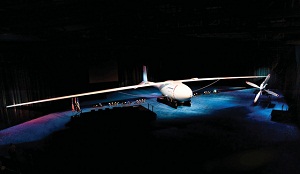Boeing to develop solar spy plane
 There is a commercial application for Boeing’s Phantom Eagle solar spy plane, it’s just probably not the precursor to a fully solar-powered jet that will carry coach class customers from Los Angeles to New York, said Chris Haddox, director of communications for Boeing’s Phantom Works program.
There is a commercial application for Boeing’s Phantom Eagle solar spy plane, it’s just probably not the precursor to a fully solar-powered jet that will carry coach class customers from Los Angeles to New York, said Chris Haddox, director of communications for Boeing’s Phantom Works program.
Boeing won $89 million in funding from the US Defense Advanced Research Projects Agency earlier this week to develop an unmanned solar spy plane that can remain in the air for five years.
The project will be Boeing’s third high-profile solar plane in the last year.
“The real key,” Haddox said, “the thing that makes this one different, is persistence.”
While there are other unmanned spy crafts hovering out there, collecting data for the department of defense, they all have to go home and charge up eventually.
The Boeing Solar Eagle, when it’s finished, will be able to generate enough solar energy to keep itself airborne and run advanced and complex communications hardware and software indefinitely. It will use the energy produced by photovoltaic panels on its massive 60-foot wings during the day and store the excess in advanced batteries, so it will be able to operate through the night and long dark spells, Haddox said.
While Boeing’s Impulse, a piloted solar craft, also had a successful 87-minute test flight earlier this year, and teams plan to fly it around the world this winter, Haddox said the company isn’t ready to make any announcements about the possible application of solar in its commercial jets.
What the new advances in solar-powered aircrafts does mean for consumers is that they will probably never have to go without their cell phones in an emergency again.
Haddox used the Haitian earthquakes as an example of a time the world would have benefited from a spy plane like the Solar Eagle.
At 65,000 feet, with all of the bells and whistles the plane will boast, it could have acted as a temporary or pseudo satellite for the whole country, Haddox said.
The Eagle is Boeing’s name for its upcoming spy plane. The DARPA Vulture II project provided the funding. Boeing beat out Lockheed Martin’s Vulture to win the money.
Boeing tested an earlier version of the spy plane, its Zephyr Phantom, earlier this year and flew it for 14 hours straight.
Haddox said Boeing hopes to be able to offer a 30-day test demonstration of the Solar Eagle by the end of the year.
Pictured: Boeing's Phantom eye spy plane, which is not solar powered...yet.



